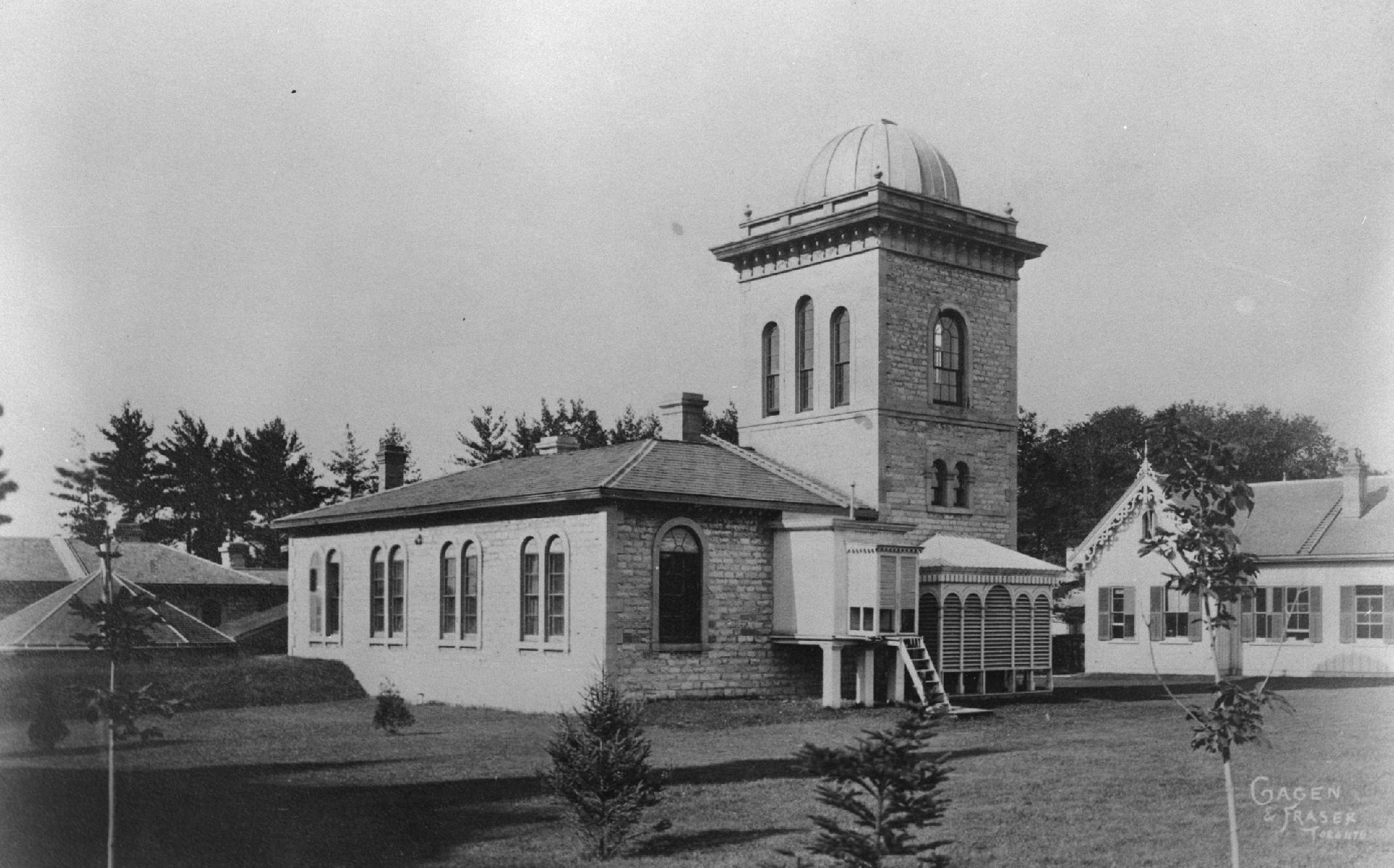We are most grateful to be able to reproduce here material from Jane Rupert's edition of Letters of a Distinguished Physician from the Royal Tour of the British North American Colonies, 1860 written by Henry Wentworth Acland. The whole edition is available on the web by clicking here.
 he Toronto Magnetic and Meteorological Observatory, located on the grounds of the University of
Toronto just west of Queen's Park, played an important part in a global scientific project that
involved observatories in both hemispheres and included scientific communities in Russia, Germany,
France, and Britain. A pioneering collaborative enterprise, the project's purpose was to investigate variations
in the earth's magnetism, an invisible force generated from the earth's molten core whose fluctuations
affect accuracy in compass readings, then a problem in navigation.
he Toronto Magnetic and Meteorological Observatory, located on the grounds of the University of
Toronto just west of Queen's Park, played an important part in a global scientific project that
involved observatories in both hemispheres and included scientific communities in Russia, Germany,
France, and Britain. A pioneering collaborative enterprise, the project's purpose was to investigate variations
in the earth's magnetism, an invisible force generated from the earth's molten core whose fluctuations
affect accuracy in compass readings, then a problem in navigation.
General Edward Sabine, who had measured magnetic variations during the Ross and Parry Arctic expeditions in 1818-20, was appointed director of the British observatories in 1839. Colonel Frederick Wilmot, assisted by Colonel John Henry Lefroy, set up Britain's observatory in the middle of the Atlantic Ocean on St. Helena's Island. In 1842, Lefroy was transferred to direct the observatory in Canada. From its base in Toronto, he undertook an eighteen-month expedition in 1843-44 to measure magnetic variations. Equipped with 180 pounds of instruments, Lefroy travelled 8,811 kilometers (5,475 miles) by canoe along the voyageur routes of the Hudson's Bay Company from Montreal to the west and far north. His observations during the aurora borealis were of particular interest to the global enterprise because they are caused by the interaction of elements in the earth's atmosphere with highly-charged electrons from solar winds that follow the lines of the earth's magnetic force. From Lefroy's observations Sabine was able to demonstrate conclusively that the eleven-year cycle of sunspots caused a similar periodic variation in the earth's magnetic field. When the British magnetic project ended in 1853, George Templeton Kingston, professor of meteorology at the fledgling University of Toronto, was appointed director of the observatory by the colonial government with 2/3 of his salary paid by the province. Until 1905 the observatory was the official timekeeper for Canada.

Gagen & Fraser, "Observatory (1857)," photograph of the Toronto Observatory, Baldwin Collection of Canadiana, Toronto Public Library.
In a letter to his wife from Toronto, Acland wrote: I need hardly recount to you the round of Regatta, Horticultural shows, laying stones, and inaugurations which Our own will relate. But I will relate some of my own work. The three things which I have paid most attention to are the Hospital, the University, the Magnetic Observatory. The latter is so well known that I need not make much remark on it. There are four great British Magnetic Observatories — St. Helena, Kew, Cape of Good Hope, Toronto. The latter is the furthest north and the most westerly. There are others, one at St. Petersburg, but the whole I cannot enumerate. The object is of course to examine & record the condition and changes of Magnetism on the earth's surface - partly for purely scientific purposes, partly for the use of the practical purposes of Navigation — The methods of observatories will not much interest you, and you had too large a dose of Dr. Smallwood. I went in company with Mr. Blackwell and Colonel Wilmot introducing them to Professor Kingston who was a Cambridge man. The institution was I suspect in more masterly order for its period when Colonel Lefroy was here. The Imperial Government formerly in his & Sabine's time supported it — and now it does credit to the Province that it allows £1200 currency (£1000) to its maintenance - The Professor has 3 Artillery Sergeants to aid him — retired non commissioned officers — of whom one Sergeant Walker has been there 22 years. Colonel Wilmot built the St. Helena Observatory & worked there 7 years: and Walker had once served under him — Professor Kingston was very obliging and answered all sorts of questions to me — concerning the structure of his instruments, and his arrangements — especially those of adjustment — On the whole the Observations is a more simple matter than I had expected, but the calculations are of the most troublesome & difficult nature.
Links to Related Material
- The Victorians and the Earth's Magnetic Field
- Dr. Henry Wentworth Acland: A Brief Biography
- The British Magnetic Scheme: People and Institutions
- Studying the Earth's Magnetic Field in India
Bibliography
Acland, Henry Wentworth. "Letter 11: Toronto" in Letters of a Distinguished Physician from the Royal Tour of the British North American Colonies, 1860. ed. Jane Rupert, web janerupert.ca
Further Reading
Lefroy, John Henry. Diary of a Magnetic Survey of a Portion of the Dominion of Canada, Chiefly in the North-West Territories, Executed in the Years 1842-1844. London: Longmans, Green, & Co., 1883.
Thomson, Andrew. "Sir Henry Lefroy — 1817-1890." Canadian Meteorological Society. Accessed 5 July 2023.
Zeller, Suzanne. Inventing Canada: Early Victorian Science and the Idea of a Transcontinental Nation. Toronto: University of Toronto Press, 1987.
Last modified 21 July 2023